COIT 20252 - Analyzing IBM's Innovation Strategy: A BPM Case Study
VerifiedAdded on 2023/06/11
|23
|6177
|162
Case Study
AI Summary
This case study provides an in-depth analysis of IBM's innovation strategy, processes, infrastructure, and organizational structure. It examines the organization's need for innovation and process changes, covering aspects such as innovation framework, culture, funding model, and business tr...
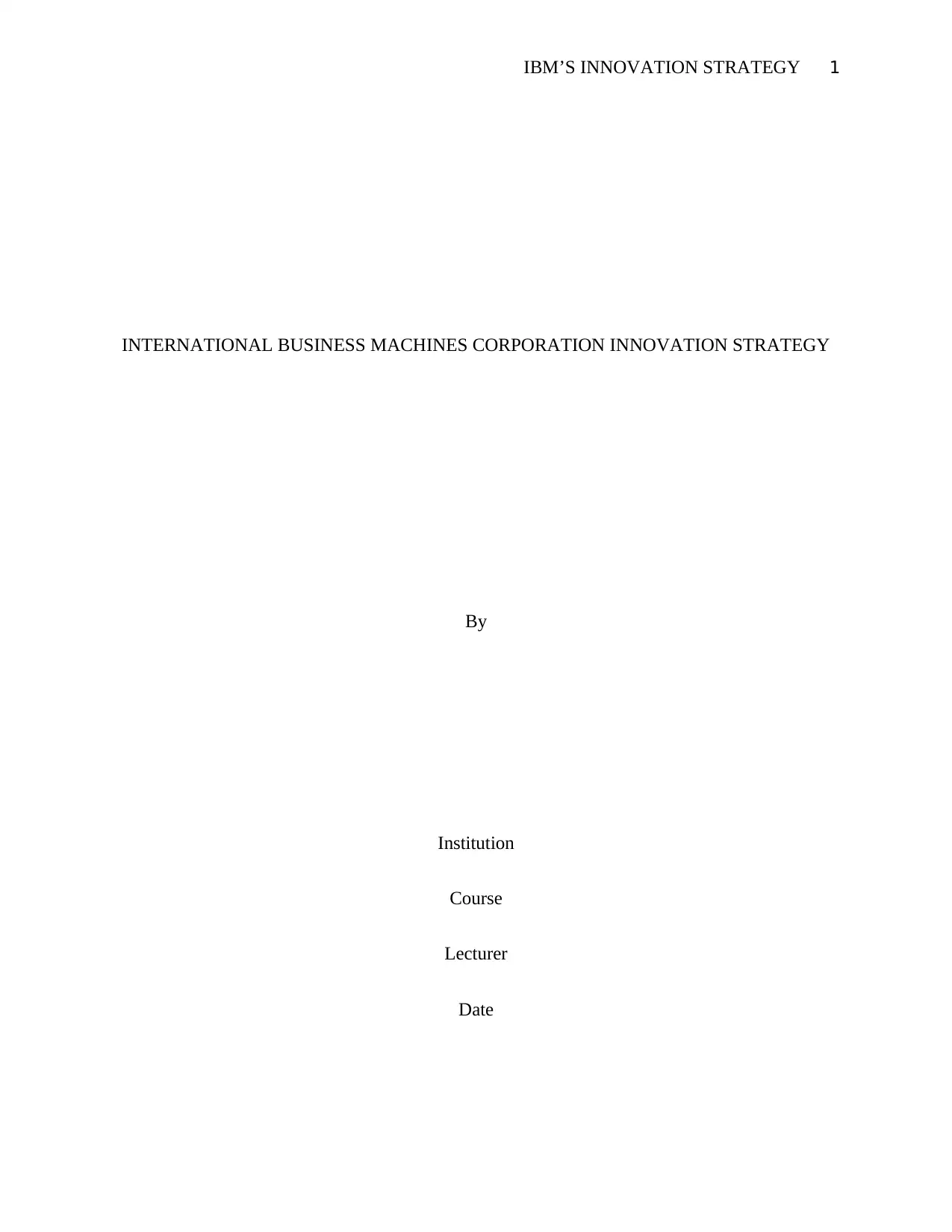
IBM’S INNOVATION STRATEGY 1
INTERNATIONAL BUSINESS MACHINES CORPORATION INNOVATION STRATEGY
By
Institution
Course
Lecturer
Date
INTERNATIONAL BUSINESS MACHINES CORPORATION INNOVATION STRATEGY
By
Institution
Course
Lecturer
Date
Paraphrase This Document
Need a fresh take? Get an instant paraphrase of this document with our AI Paraphraser

IBM’S INNOVATION STRATEGY 2
Executive Summary
The following report presents an analysis of the innovation journey of what has been
described as the most innovative company, International Business Machines Corporation (IBM).
It critically analyzes the various aspects of the organization's innovation qualitatively to identify
the organization’s need for process changes and innovation, its process performance evaluation,
business process design and improvement and potential risks. Under the organization need for
innovation, the report puts into consideration aspects such as innovation framework and culture,
funding model, organization structure and design as well as business transformation and
integration. It also analyzes organization’s business process design through the use of
stakeholder engagement, the role of leadership in the innovation process and involvement of
leadership to drive innovation in the organization. The reports also document the main methods
used by the organization to evaluate its performance. The discussed methods are balanced
scorecard and the use of cycle time. Finally, the various strategies used by the organization to
deal with failure are also discussed. In addition, the report analyses various enablers and barriers
to innovation such as lack of adequate research and lack of focus on different markets and
products. It also analyses the critical success factors for the innovation process within the
organization, documents the main lessons that can be drawn from the IBM case Study and
concludes with a summary of main points covered in the report.
Executive Summary
The following report presents an analysis of the innovation journey of what has been
described as the most innovative company, International Business Machines Corporation (IBM).
It critically analyzes the various aspects of the organization's innovation qualitatively to identify
the organization’s need for process changes and innovation, its process performance evaluation,
business process design and improvement and potential risks. Under the organization need for
innovation, the report puts into consideration aspects such as innovation framework and culture,
funding model, organization structure and design as well as business transformation and
integration. It also analyzes organization’s business process design through the use of
stakeholder engagement, the role of leadership in the innovation process and involvement of
leadership to drive innovation in the organization. The reports also document the main methods
used by the organization to evaluate its performance. The discussed methods are balanced
scorecard and the use of cycle time. Finally, the various strategies used by the organization to
deal with failure are also discussed. In addition, the report analyses various enablers and barriers
to innovation such as lack of adequate research and lack of focus on different markets and
products. It also analyses the critical success factors for the innovation process within the
organization, documents the main lessons that can be drawn from the IBM case Study and
concludes with a summary of main points covered in the report.
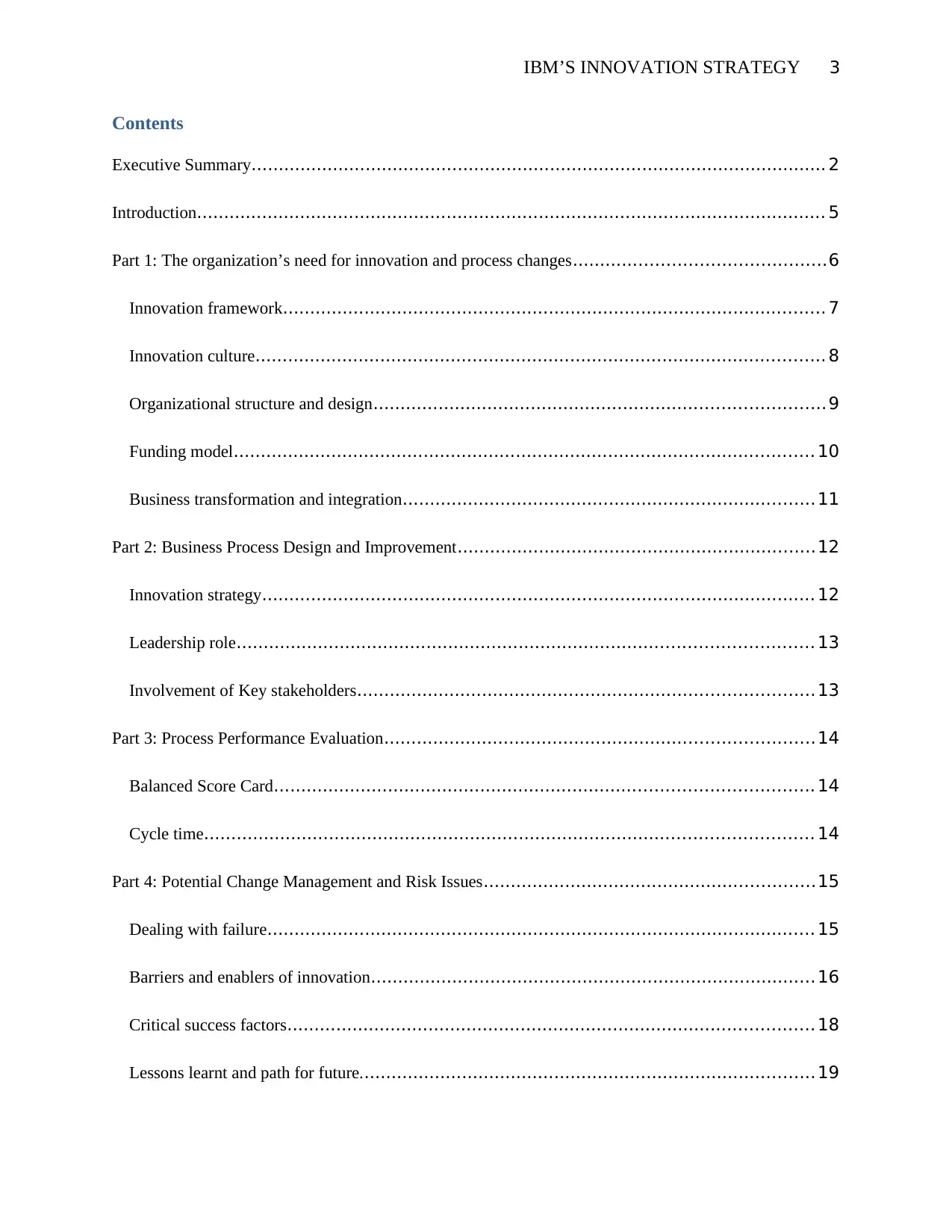
IBM’S INNOVATION STRATEGY 3
Contents
Executive Summary.......................................................................................................... 2
Introduction.................................................................................................................... 5
Part 1: The organization’s need for innovation and process changes..............................................6
Innovation framework.................................................................................................... 7
Innovation culture......................................................................................................... 8
Organizational structure and design...................................................................................9
Funding model........................................................................................................... 10
Business transformation and integration............................................................................11
Part 2: Business Process Design and Improvement..................................................................12
Innovation strategy...................................................................................................... 12
Leadership role.......................................................................................................... 13
Involvement of Key stakeholders....................................................................................13
Part 3: Process Performance Evaluation...............................................................................14
Balanced Score Card................................................................................................... 14
Cycle time................................................................................................................ 14
Part 4: Potential Change Management and Risk Issues.............................................................15
Dealing with failure..................................................................................................... 15
Barriers and enablers of innovation.................................................................................. 16
Critical success factors................................................................................................. 18
Lessons learnt and path for future....................................................................................19
Contents
Executive Summary.......................................................................................................... 2
Introduction.................................................................................................................... 5
Part 1: The organization’s need for innovation and process changes..............................................6
Innovation framework.................................................................................................... 7
Innovation culture......................................................................................................... 8
Organizational structure and design...................................................................................9
Funding model........................................................................................................... 10
Business transformation and integration............................................................................11
Part 2: Business Process Design and Improvement..................................................................12
Innovation strategy...................................................................................................... 12
Leadership role.......................................................................................................... 13
Involvement of Key stakeholders....................................................................................13
Part 3: Process Performance Evaluation...............................................................................14
Balanced Score Card................................................................................................... 14
Cycle time................................................................................................................ 14
Part 4: Potential Change Management and Risk Issues.............................................................15
Dealing with failure..................................................................................................... 15
Barriers and enablers of innovation.................................................................................. 16
Critical success factors................................................................................................. 18
Lessons learnt and path for future....................................................................................19
You're viewing a preview
Unlock full access by subscribing today!
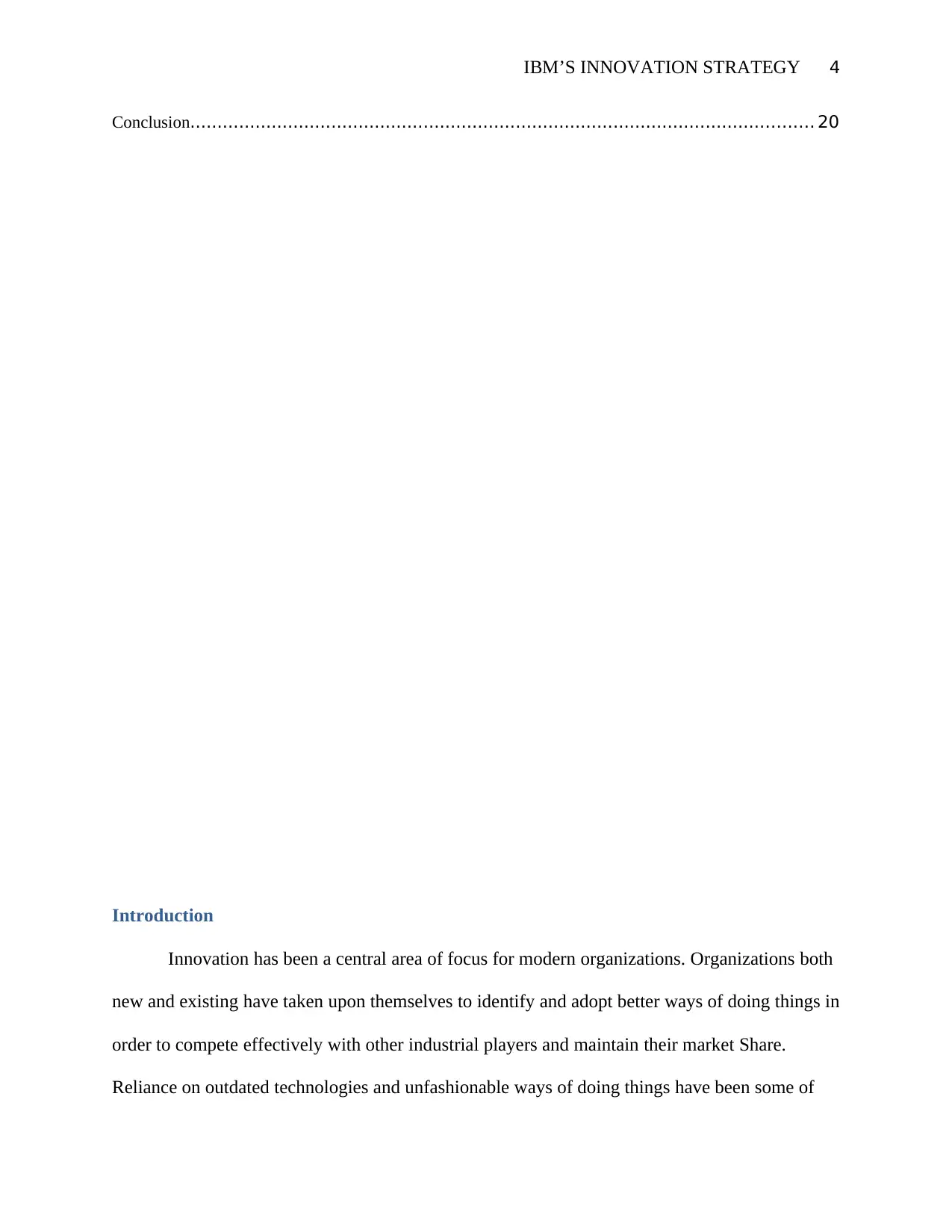
IBM’S INNOVATION STRATEGY 4
Conclusion................................................................................................................... 20
Introduction
Innovation has been a central area of focus for modern organizations. Organizations both
new and existing have taken upon themselves to identify and adopt better ways of doing things in
order to compete effectively with other industrial players and maintain their market Share.
Reliance on outdated technologies and unfashionable ways of doing things have been some of
Conclusion................................................................................................................... 20
Introduction
Innovation has been a central area of focus for modern organizations. Organizations both
new and existing have taken upon themselves to identify and adopt better ways of doing things in
order to compete effectively with other industrial players and maintain their market Share.
Reliance on outdated technologies and unfashionable ways of doing things have been some of
Paraphrase This Document
Need a fresh take? Get an instant paraphrase of this document with our AI Paraphraser
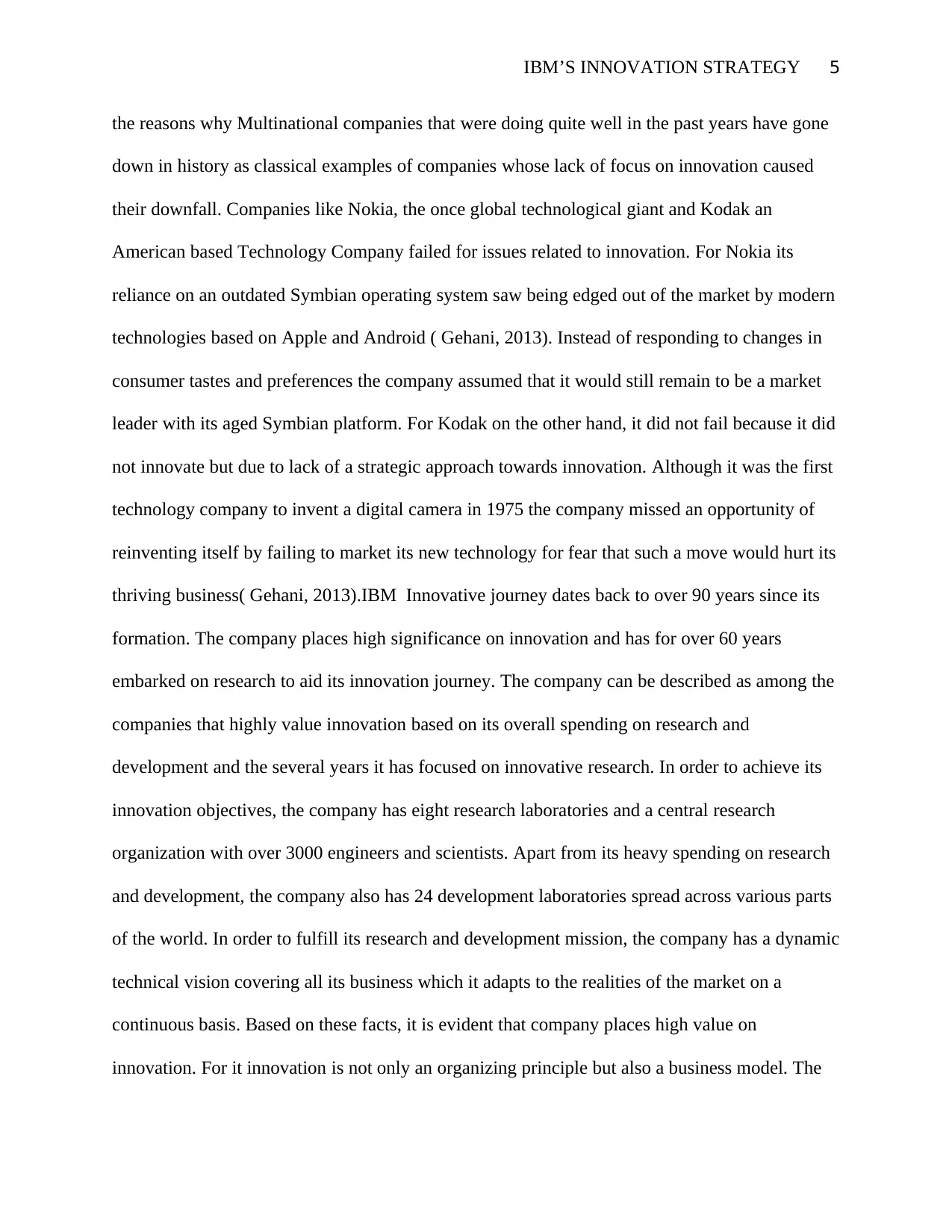
IBM’S INNOVATION STRATEGY 5
the reasons why Multinational companies that were doing quite well in the past years have gone
down in history as classical examples of companies whose lack of focus on innovation caused
their downfall. Companies like Nokia, the once global technological giant and Kodak an
American based Technology Company failed for issues related to innovation. For Nokia its
reliance on an outdated Symbian operating system saw being edged out of the market by modern
technologies based on Apple and Android ( Gehani, 2013). Instead of responding to changes in
consumer tastes and preferences the company assumed that it would still remain to be a market
leader with its aged Symbian platform. For Kodak on the other hand, it did not fail because it did
not innovate but due to lack of a strategic approach towards innovation. Although it was the first
technology company to invent a digital camera in 1975 the company missed an opportunity of
reinventing itself by failing to market its new technology for fear that such a move would hurt its
thriving business( Gehani, 2013).IBM Innovative journey dates back to over 90 years since its
formation. The company places high significance on innovation and has for over 60 years
embarked on research to aid its innovation journey. The company can be described as among the
companies that highly value innovation based on its overall spending on research and
development and the several years it has focused on innovative research. In order to achieve its
innovation objectives, the company has eight research laboratories and a central research
organization with over 3000 engineers and scientists. Apart from its heavy spending on research
and development, the company also has 24 development laboratories spread across various parts
of the world. In order to fulfill its research and development mission, the company has a dynamic
technical vision covering all its business which it adapts to the realities of the market on a
continuous basis. Based on these facts, it is evident that company places high value on
innovation. For it innovation is not only an organizing principle but also a business model. The
the reasons why Multinational companies that were doing quite well in the past years have gone
down in history as classical examples of companies whose lack of focus on innovation caused
their downfall. Companies like Nokia, the once global technological giant and Kodak an
American based Technology Company failed for issues related to innovation. For Nokia its
reliance on an outdated Symbian operating system saw being edged out of the market by modern
technologies based on Apple and Android ( Gehani, 2013). Instead of responding to changes in
consumer tastes and preferences the company assumed that it would still remain to be a market
leader with its aged Symbian platform. For Kodak on the other hand, it did not fail because it did
not innovate but due to lack of a strategic approach towards innovation. Although it was the first
technology company to invent a digital camera in 1975 the company missed an opportunity of
reinventing itself by failing to market its new technology for fear that such a move would hurt its
thriving business( Gehani, 2013).IBM Innovative journey dates back to over 90 years since its
formation. The company places high significance on innovation and has for over 60 years
embarked on research to aid its innovation journey. The company can be described as among the
companies that highly value innovation based on its overall spending on research and
development and the several years it has focused on innovative research. In order to achieve its
innovation objectives, the company has eight research laboratories and a central research
organization with over 3000 engineers and scientists. Apart from its heavy spending on research
and development, the company also has 24 development laboratories spread across various parts
of the world. In order to fulfill its research and development mission, the company has a dynamic
technical vision covering all its business which it adapts to the realities of the market on a
continuous basis. Based on these facts, it is evident that company places high value on
innovation. For it innovation is not only an organizing principle but also a business model. The
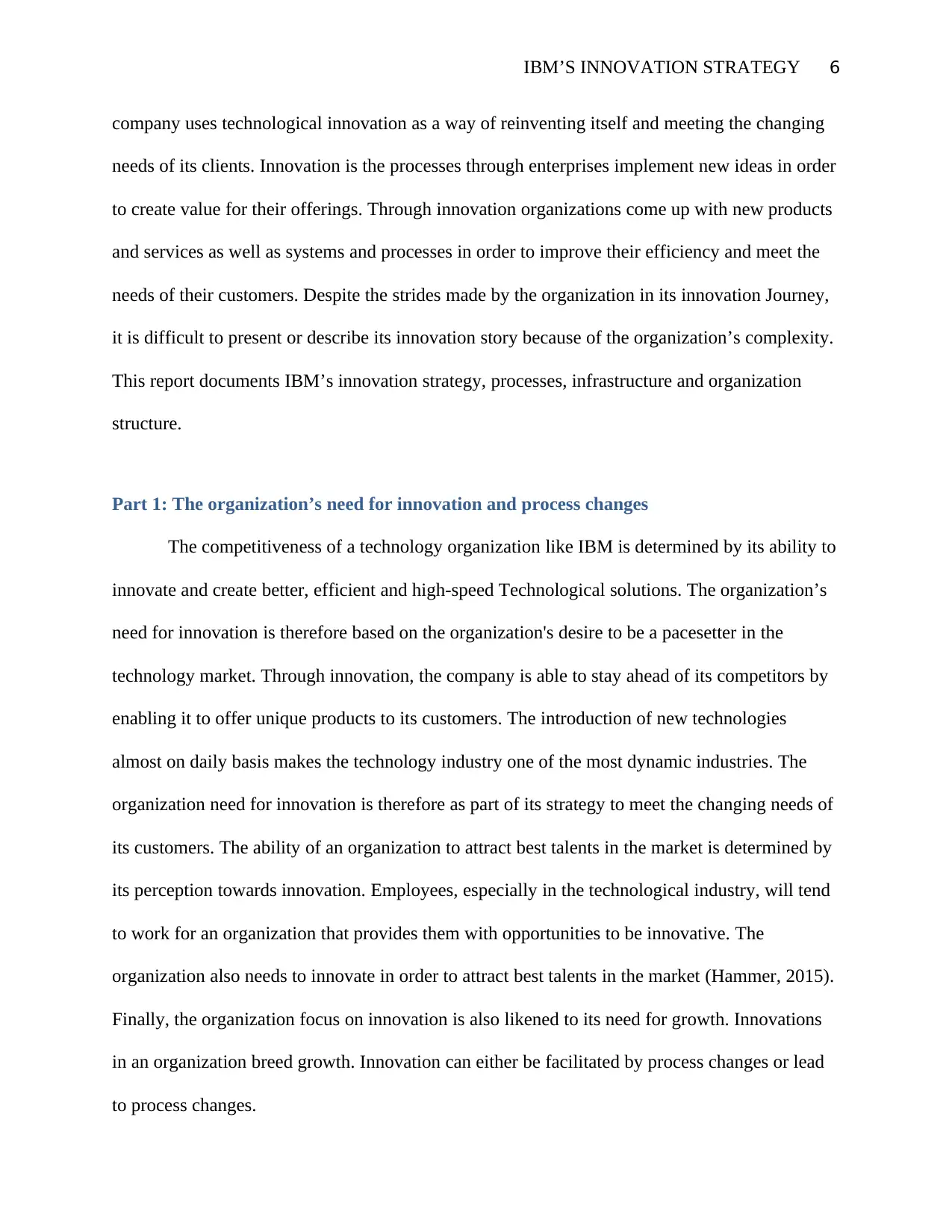
IBM’S INNOVATION STRATEGY 6
company uses technological innovation as a way of reinventing itself and meeting the changing
needs of its clients. Innovation is the processes through enterprises implement new ideas in order
to create value for their offerings. Through innovation organizations come up with new products
and services as well as systems and processes in order to improve their efficiency and meet the
needs of their customers. Despite the strides made by the organization in its innovation Journey,
it is difficult to present or describe its innovation story because of the organization’s complexity.
This report documents IBM’s innovation strategy, processes, infrastructure and organization
structure.
Part 1: The organization’s need for innovation and process changes
The competitiveness of a technology organization like IBM is determined by its ability to
innovate and create better, efficient and high-speed Technological solutions. The organization’s
need for innovation is therefore based on the organization's desire to be a pacesetter in the
technology market. Through innovation, the company is able to stay ahead of its competitors by
enabling it to offer unique products to its customers. The introduction of new technologies
almost on daily basis makes the technology industry one of the most dynamic industries. The
organization need for innovation is therefore as part of its strategy to meet the changing needs of
its customers. The ability of an organization to attract best talents in the market is determined by
its perception towards innovation. Employees, especially in the technological industry, will tend
to work for an organization that provides them with opportunities to be innovative. The
organization also needs to innovate in order to attract best talents in the market (Hammer, 2015).
Finally, the organization focus on innovation is also likened to its need for growth. Innovations
in an organization breed growth. Innovation can either be facilitated by process changes or lead
to process changes.
company uses technological innovation as a way of reinventing itself and meeting the changing
needs of its clients. Innovation is the processes through enterprises implement new ideas in order
to create value for their offerings. Through innovation organizations come up with new products
and services as well as systems and processes in order to improve their efficiency and meet the
needs of their customers. Despite the strides made by the organization in its innovation Journey,
it is difficult to present or describe its innovation story because of the organization’s complexity.
This report documents IBM’s innovation strategy, processes, infrastructure and organization
structure.
Part 1: The organization’s need for innovation and process changes
The competitiveness of a technology organization like IBM is determined by its ability to
innovate and create better, efficient and high-speed Technological solutions. The organization’s
need for innovation is therefore based on the organization's desire to be a pacesetter in the
technology market. Through innovation, the company is able to stay ahead of its competitors by
enabling it to offer unique products to its customers. The introduction of new technologies
almost on daily basis makes the technology industry one of the most dynamic industries. The
organization need for innovation is therefore as part of its strategy to meet the changing needs of
its customers. The ability of an organization to attract best talents in the market is determined by
its perception towards innovation. Employees, especially in the technological industry, will tend
to work for an organization that provides them with opportunities to be innovative. The
organization also needs to innovate in order to attract best talents in the market (Hammer, 2015).
Finally, the organization focus on innovation is also likened to its need for growth. Innovations
in an organization breed growth. Innovation can either be facilitated by process changes or lead
to process changes.
You're viewing a preview
Unlock full access by subscribing today!
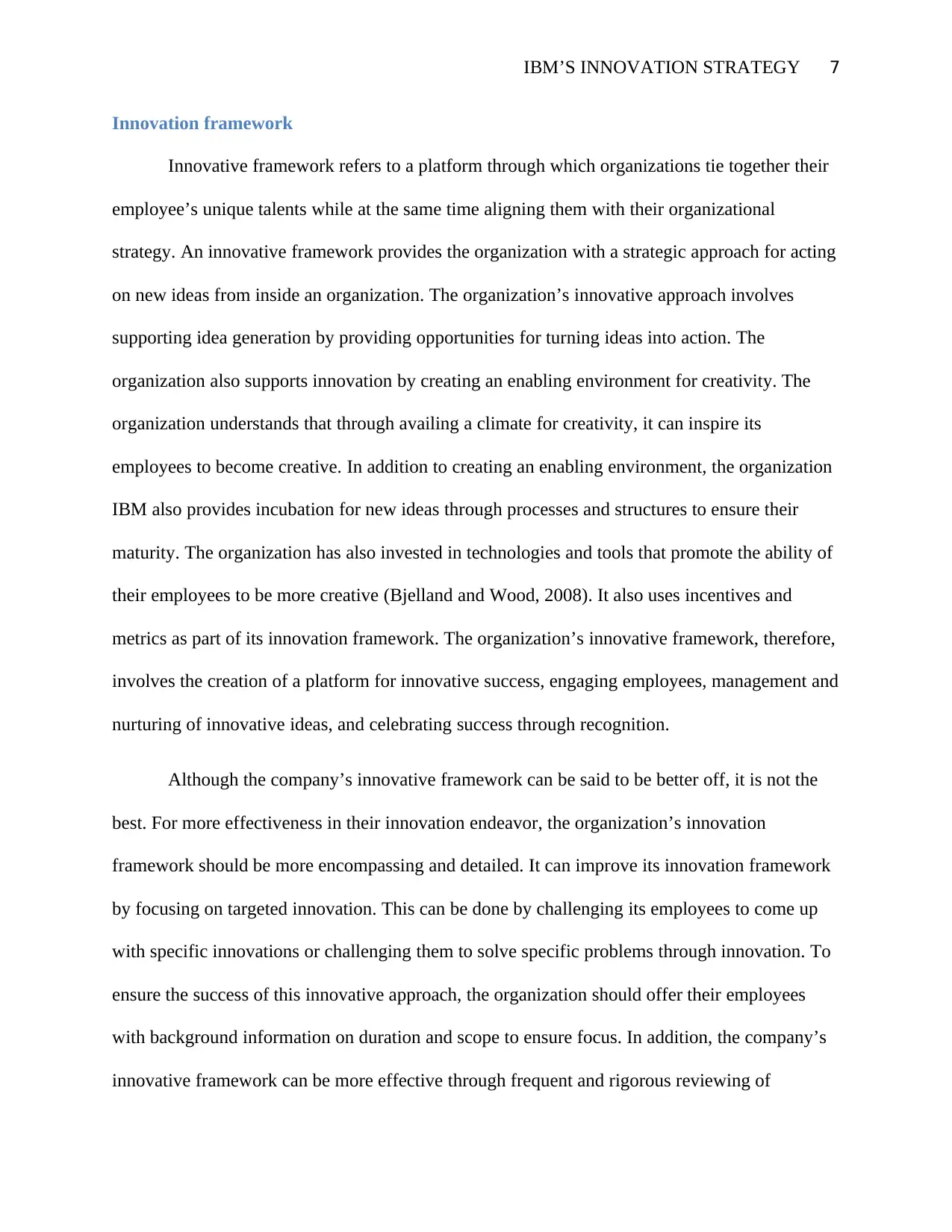
IBM’S INNOVATION STRATEGY 7
Innovation framework
Innovative framework refers to a platform through which organizations tie together their
employee’s unique talents while at the same time aligning them with their organizational
strategy. An innovative framework provides the organization with a strategic approach for acting
on new ideas from inside an organization. The organization’s innovative approach involves
supporting idea generation by providing opportunities for turning ideas into action. The
organization also supports innovation by creating an enabling environment for creativity. The
organization understands that through availing a climate for creativity, it can inspire its
employees to become creative. In addition to creating an enabling environment, the organization
IBM also provides incubation for new ideas through processes and structures to ensure their
maturity. The organization has also invested in technologies and tools that promote the ability of
their employees to be more creative (Bjelland and Wood, 2008). It also uses incentives and
metrics as part of its innovation framework. The organization’s innovative framework, therefore,
involves the creation of a platform for innovative success, engaging employees, management and
nurturing of innovative ideas, and celebrating success through recognition.
Although the company’s innovative framework can be said to be better off, it is not the
best. For more effectiveness in their innovation endeavor, the organization’s innovation
framework should be more encompassing and detailed. It can improve its innovation framework
by focusing on targeted innovation. This can be done by challenging its employees to come up
with specific innovations or challenging them to solve specific problems through innovation. To
ensure the success of this innovative approach, the organization should offer their employees
with background information on duration and scope to ensure focus. In addition, the company’s
innovative framework can be more effective through frequent and rigorous reviewing of
Innovation framework
Innovative framework refers to a platform through which organizations tie together their
employee’s unique talents while at the same time aligning them with their organizational
strategy. An innovative framework provides the organization with a strategic approach for acting
on new ideas from inside an organization. The organization’s innovative approach involves
supporting idea generation by providing opportunities for turning ideas into action. The
organization also supports innovation by creating an enabling environment for creativity. The
organization understands that through availing a climate for creativity, it can inspire its
employees to become creative. In addition to creating an enabling environment, the organization
IBM also provides incubation for new ideas through processes and structures to ensure their
maturity. The organization has also invested in technologies and tools that promote the ability of
their employees to be more creative (Bjelland and Wood, 2008). It also uses incentives and
metrics as part of its innovation framework. The organization’s innovative framework, therefore,
involves the creation of a platform for innovative success, engaging employees, management and
nurturing of innovative ideas, and celebrating success through recognition.
Although the company’s innovative framework can be said to be better off, it is not the
best. For more effectiveness in their innovation endeavor, the organization’s innovation
framework should be more encompassing and detailed. It can improve its innovation framework
by focusing on targeted innovation. This can be done by challenging its employees to come up
with specific innovations or challenging them to solve specific problems through innovation. To
ensure the success of this innovative approach, the organization should offer their employees
with background information on duration and scope to ensure focus. In addition, the company’s
innovative framework can be more effective through frequent and rigorous reviewing of
Paraphrase This Document
Need a fresh take? Get an instant paraphrase of this document with our AI Paraphraser
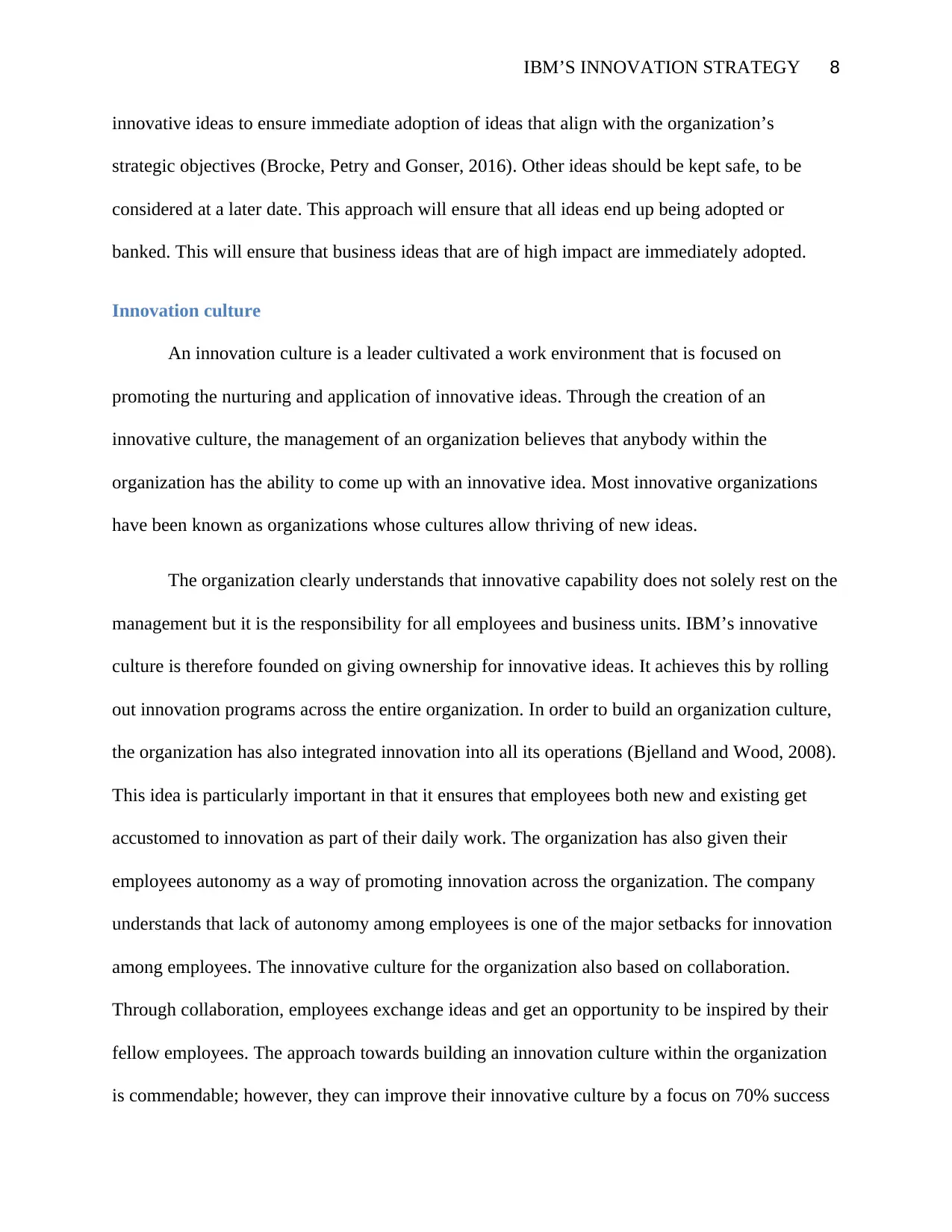
IBM’S INNOVATION STRATEGY 8
innovative ideas to ensure immediate adoption of ideas that align with the organization’s
strategic objectives (Brocke, Petry and Gonser, 2016). Other ideas should be kept safe, to be
considered at a later date. This approach will ensure that all ideas end up being adopted or
banked. This will ensure that business ideas that are of high impact are immediately adopted.
Innovation culture
An innovation culture is a leader cultivated a work environment that is focused on
promoting the nurturing and application of innovative ideas. Through the creation of an
innovative culture, the management of an organization believes that anybody within the
organization has the ability to come up with an innovative idea. Most innovative organizations
have been known as organizations whose cultures allow thriving of new ideas.
The organization clearly understands that innovative capability does not solely rest on the
management but it is the responsibility for all employees and business units. IBM’s innovative
culture is therefore founded on giving ownership for innovative ideas. It achieves this by rolling
out innovation programs across the entire organization. In order to build an organization culture,
the organization has also integrated innovation into all its operations (Bjelland and Wood, 2008).
This idea is particularly important in that it ensures that employees both new and existing get
accustomed to innovation as part of their daily work. The organization has also given their
employees autonomy as a way of promoting innovation across the organization. The company
understands that lack of autonomy among employees is one of the major setbacks for innovation
among employees. The innovative culture for the organization also based on collaboration.
Through collaboration, employees exchange ideas and get an opportunity to be inspired by their
fellow employees. The approach towards building an innovation culture within the organization
is commendable; however, they can improve their innovative culture by a focus on 70% success
innovative ideas to ensure immediate adoption of ideas that align with the organization’s
strategic objectives (Brocke, Petry and Gonser, 2016). Other ideas should be kept safe, to be
considered at a later date. This approach will ensure that all ideas end up being adopted or
banked. This will ensure that business ideas that are of high impact are immediately adopted.
Innovation culture
An innovation culture is a leader cultivated a work environment that is focused on
promoting the nurturing and application of innovative ideas. Through the creation of an
innovative culture, the management of an organization believes that anybody within the
organization has the ability to come up with an innovative idea. Most innovative organizations
have been known as organizations whose cultures allow thriving of new ideas.
The organization clearly understands that innovative capability does not solely rest on the
management but it is the responsibility for all employees and business units. IBM’s innovative
culture is therefore founded on giving ownership for innovative ideas. It achieves this by rolling
out innovation programs across the entire organization. In order to build an organization culture,
the organization has also integrated innovation into all its operations (Bjelland and Wood, 2008).
This idea is particularly important in that it ensures that employees both new and existing get
accustomed to innovation as part of their daily work. The organization has also given their
employees autonomy as a way of promoting innovation across the organization. The company
understands that lack of autonomy among employees is one of the major setbacks for innovation
among employees. The innovative culture for the organization also based on collaboration.
Through collaboration, employees exchange ideas and get an opportunity to be inspired by their
fellow employees. The approach towards building an innovation culture within the organization
is commendable; however, they can improve their innovative culture by a focus on 70% success

IBM’S INNOVATION STRATEGY 9
instead of 100% success. This will make their employees more willing to take risks. It can also
strengthen its innovation culture by challenging its employees with difficult projects and
prioritizing the employees less likely to successfully complete projects.
Organizational structure and design
The structure of an organization refers to a system outlining how its activities are directed
in order to achieve organizational goals and objectives. Organization structure defines activities
such as responsibilities, roles, and rules. The structure also determines the flow of information
from different levels within an organization. The different types of organizational structures
adopted by an organization include flatachry, matrix, divisional and functional (Hung, 2006). On
the other hand organization design is the process used by the organization in aligning its
structure with its objectives as a way of enhancing effectiveness and organizational efficiency.
The organization structure for the company can be referred to as a functional organization
structure. It involves capacitating employees at all levels and operational units within the
organization to be in control of the innovative processes within the organization (Ko, Lee and
Lee, 2009). It perceives the ownership of innovation as a responsibility for employees at all
levels and functional units within the organization. This means that the innovative power and
authority rests with individual employees and units within the organization. Innovation is
integrated into employee’s roles and the functioning of every business unit.
This is advantageous in that it removes the possible bureaucratic hurdles that would
hinder innovation in the organization especially where there is a heavy reliance on the top
management for innovation decisions approval. The disadvantage, however, is that it might be
challenging for Nick Donofrio, the company’s second-ranking executive to coordinate
communication on innovation matters across different units.
instead of 100% success. This will make their employees more willing to take risks. It can also
strengthen its innovation culture by challenging its employees with difficult projects and
prioritizing the employees less likely to successfully complete projects.
Organizational structure and design
The structure of an organization refers to a system outlining how its activities are directed
in order to achieve organizational goals and objectives. Organization structure defines activities
such as responsibilities, roles, and rules. The structure also determines the flow of information
from different levels within an organization. The different types of organizational structures
adopted by an organization include flatachry, matrix, divisional and functional (Hung, 2006). On
the other hand organization design is the process used by the organization in aligning its
structure with its objectives as a way of enhancing effectiveness and organizational efficiency.
The organization structure for the company can be referred to as a functional organization
structure. It involves capacitating employees at all levels and operational units within the
organization to be in control of the innovative processes within the organization (Ko, Lee and
Lee, 2009). It perceives the ownership of innovation as a responsibility for employees at all
levels and functional units within the organization. This means that the innovative power and
authority rests with individual employees and units within the organization. Innovation is
integrated into employee’s roles and the functioning of every business unit.
This is advantageous in that it removes the possible bureaucratic hurdles that would
hinder innovation in the organization especially where there is a heavy reliance on the top
management for innovation decisions approval. The disadvantage, however, is that it might be
challenging for Nick Donofrio, the company’s second-ranking executive to coordinate
communication on innovation matters across different units.
You're viewing a preview
Unlock full access by subscribing today!

IBM’S INNOVATION STRATEGY 10
Funding model
In the IBM case context, a funding model refers to the direct support provide by the
organization to supplement and assist in the financial viability of innovation. Funding is an
important aspect of the implementation process for innovations. Lack of effective and sufficient
funding is detrimental to the innovative capability of both an organization and its employees.
External funding is done through co-development with clients, universities or business partners.
Internal funding is managed by individual business units whereby each unit determines its
financial estimates for innovation and includes it in the budget. The budget is then justified by
leaders of specific units. For budgets cutting across the organization, the corporate strategy group
is tasked with the responsibility of helping in the funding process for innovation (Chesbrough,
2007). Although the determination of funding for innovation and potential areas of growth is the
sole responsibility of individual business units, they can seek the intervention of the corporate
level of the organization if need be. The organization’s emerging business opportunity program
responsible for the allocation of funding and resources for innovative business opportunities .The
program is funded by the organization’s business units and managed by operational and finance
staff, EBO leaders, finance and corporate strategy.
The organization has a very comprehensive funding model for innovation. Its model is
meant to ensure that all innovations from all the levels are taken care of. Availability of a
comprehensive funding model for innovation is a means that the organization's employees are
motivated to become more creative. It also minimizes the possibility of innovative ideas being
discarded for lack of funding.
Funding model
In the IBM case context, a funding model refers to the direct support provide by the
organization to supplement and assist in the financial viability of innovation. Funding is an
important aspect of the implementation process for innovations. Lack of effective and sufficient
funding is detrimental to the innovative capability of both an organization and its employees.
External funding is done through co-development with clients, universities or business partners.
Internal funding is managed by individual business units whereby each unit determines its
financial estimates for innovation and includes it in the budget. The budget is then justified by
leaders of specific units. For budgets cutting across the organization, the corporate strategy group
is tasked with the responsibility of helping in the funding process for innovation (Chesbrough,
2007). Although the determination of funding for innovation and potential areas of growth is the
sole responsibility of individual business units, they can seek the intervention of the corporate
level of the organization if need be. The organization’s emerging business opportunity program
responsible for the allocation of funding and resources for innovative business opportunities .The
program is funded by the organization’s business units and managed by operational and finance
staff, EBO leaders, finance and corporate strategy.
The organization has a very comprehensive funding model for innovation. Its model is
meant to ensure that all innovations from all the levels are taken care of. Availability of a
comprehensive funding model for innovation is a means that the organization's employees are
motivated to become more creative. It also minimizes the possibility of innovative ideas being
discarded for lack of funding.
Paraphrase This Document
Need a fresh take? Get an instant paraphrase of this document with our AI Paraphraser

IBM’S INNOVATION STRATEGY 11
Business transformation and integration
Business transformation refers to the process of incorporating changes in an organization
in order to meet specific goals and objectives. Business integration on the other hand is the
process aligning technology with business goals and strategy through synchronization of culture
and Information technology. It is concerned with the absorption of IT as a business function.
The focus on innovation across major functional areas of the organization is part of the
organization is driven by the need of the organization to incorporate changes aimed at enhancing
productivity levels, enhancing sales results, increasing the levels of satisfaction and efficiency.
The organization has effectively used the two functions to enhance its innovative capability
(Longo, Giaccone and Garraffo, 2013). While the adoption of innovation across all levels is an
effective way of driving a transformation agenda in the organization, management of the
innovation across levels and through collaboration is an effective strategy for creating integration
in the organization. The organization needs to continuously work on enhancing innovation
through business transformation and facilitating effective integration among its different units
Part 2: Business Process Design and Improvement
Innovation strategy
An innovation strategy refers to the plan used by organizations through the investment of
money in research and development. Innovation strategy is meant to encourage technological
advancement. An innovation strategy is effective in driving innovation across the various
functional units of an organization.
Business transformation and integration
Business transformation refers to the process of incorporating changes in an organization
in order to meet specific goals and objectives. Business integration on the other hand is the
process aligning technology with business goals and strategy through synchronization of culture
and Information technology. It is concerned with the absorption of IT as a business function.
The focus on innovation across major functional areas of the organization is part of the
organization is driven by the need of the organization to incorporate changes aimed at enhancing
productivity levels, enhancing sales results, increasing the levels of satisfaction and efficiency.
The organization has effectively used the two functions to enhance its innovative capability
(Longo, Giaccone and Garraffo, 2013). While the adoption of innovation across all levels is an
effective way of driving a transformation agenda in the organization, management of the
innovation across levels and through collaboration is an effective strategy for creating integration
in the organization. The organization needs to continuously work on enhancing innovation
through business transformation and facilitating effective integration among its different units
Part 2: Business Process Design and Improvement
Innovation strategy
An innovation strategy refers to the plan used by organizations through the investment of
money in research and development. Innovation strategy is meant to encourage technological
advancement. An innovation strategy is effective in driving innovation across the various
functional units of an organization.

IBM’S INNOVATION STRATEGY 12
The organization has a proactive innovation strategy largely driven by the organization’s
Global Technology outlook which has been in existence for the last 25 years (Hammer, 2015).
The GTO is tasked with the responsibility of projecting Key IT developments and trends and
influencing organizational technical strategy. The company’s strategy includes focussing on any
opportunities for growth. Through research, the GTO identity’s any trends in the market in both
disruptive technologies and likely to affect the IT sector. Its innovative strategy also involves
reliance on the generation of ideas. Over 100 ideas are generated by the GTO on yearly basis.
These ideas include ideas generated by employees. The process of reviewing generated ideas is a
collaborative effort involving the input of 12 teams.
The approach of the organization is towards innovation is quite good. It is both
encouraging and motivating to the employees. A collaborative approach is the most effective for
enhancing innovation in an organization. The organization has strategically positioned itself as a
market leader by constantly engaging in research and maintaining a ready to act attitude towards
any opportunities. However, the organization’s innovative strategy lacks some critical aspects
that would have made it more effective. An innovative strategy needs to be more specific and
inspiring. It should also explain the desirable future states within the organization in as far as
innovation is concerned(Majchrzak and Malhotra, 2013).Additionally, the organization’s
innovative strategy is more concerned on the competition. An effective innovation strategy needs
to focus more on breaking away from competition, beating the competition and maintain a new
space in the market.
Leadership role
Business process design and improvement are aimed at meeting certain objectives. The
role of leadership in business process design and improvement is therefore very important. The
The organization has a proactive innovation strategy largely driven by the organization’s
Global Technology outlook which has been in existence for the last 25 years (Hammer, 2015).
The GTO is tasked with the responsibility of projecting Key IT developments and trends and
influencing organizational technical strategy. The company’s strategy includes focussing on any
opportunities for growth. Through research, the GTO identity’s any trends in the market in both
disruptive technologies and likely to affect the IT sector. Its innovative strategy also involves
reliance on the generation of ideas. Over 100 ideas are generated by the GTO on yearly basis.
These ideas include ideas generated by employees. The process of reviewing generated ideas is a
collaborative effort involving the input of 12 teams.
The approach of the organization is towards innovation is quite good. It is both
encouraging and motivating to the employees. A collaborative approach is the most effective for
enhancing innovation in an organization. The organization has strategically positioned itself as a
market leader by constantly engaging in research and maintaining a ready to act attitude towards
any opportunities. However, the organization’s innovative strategy lacks some critical aspects
that would have made it more effective. An innovative strategy needs to be more specific and
inspiring. It should also explain the desirable future states within the organization in as far as
innovation is concerned(Majchrzak and Malhotra, 2013).Additionally, the organization’s
innovative strategy is more concerned on the competition. An effective innovation strategy needs
to focus more on breaking away from competition, beating the competition and maintain a new
space in the market.
Leadership role
Business process design and improvement are aimed at meeting certain objectives. The
role of leadership in business process design and improvement is therefore very important. The
You're viewing a preview
Unlock full access by subscribing today!

IBM’S INNOVATION STRATEGY 13
organization's leadership plays an active role in facilitating the change process. The active
involvement of the organization’s leadership is a boost to the process
Involvement of Key stakeholders
Business process design and improvement are focused on introducing critical changes in
an organization in order to increase productivity and efficiency (Gehani, 2013). With the nature
of change process in an organization, collaboration is a major facilitator for the process. The
organization perceives the role of Collaboration as significant in driving the innovation agenda
throughout the organization. The process involves the input of both internal and external
stakeholders. Collaboration is the most effective strategy for dealing with any hindrances to the
transition process. The involvement of stakeholders by the organization is, therefore, a strategic
move.
Part 3: Process Performance Evaluation
Process performance evaluation is the process of assessing the performance of an
ongoing process to ascertain whether it is being carried out as per the goals and objectives. The
evaluation is also meant to determine the level of achievement of the stated objectives
Balanced Score Card
This the performance evaluation process used by the organization. Balanced scorecard is
a tool used to track execution process of a project or activities.IBM majorly relies on this method
to measure its innovation and performance. The scorecard is made up of a combination of
measures intended to aid in the evaluation of the overall success of innovation. Its balanced
scorecard also has both quantitative and qualitative measures (Majchrzak and Malhotra, 2013).
The scorecard involves aspects such as goals, accomplishments, patents, eternal recognition and
organization's leadership plays an active role in facilitating the change process. The active
involvement of the organization’s leadership is a boost to the process
Involvement of Key stakeholders
Business process design and improvement are focused on introducing critical changes in
an organization in order to increase productivity and efficiency (Gehani, 2013). With the nature
of change process in an organization, collaboration is a major facilitator for the process. The
organization perceives the role of Collaboration as significant in driving the innovation agenda
throughout the organization. The process involves the input of both internal and external
stakeholders. Collaboration is the most effective strategy for dealing with any hindrances to the
transition process. The involvement of stakeholders by the organization is, therefore, a strategic
move.
Part 3: Process Performance Evaluation
Process performance evaluation is the process of assessing the performance of an
ongoing process to ascertain whether it is being carried out as per the goals and objectives. The
evaluation is also meant to determine the level of achievement of the stated objectives
Balanced Score Card
This the performance evaluation process used by the organization. Balanced scorecard is
a tool used to track execution process of a project or activities.IBM majorly relies on this method
to measure its innovation and performance. The scorecard is made up of a combination of
measures intended to aid in the evaluation of the overall success of innovation. Its balanced
scorecard also has both quantitative and qualitative measures (Majchrzak and Malhotra, 2013).
The scorecard involves aspects such as goals, accomplishments, patents, eternal recognition and
Paraphrase This Document
Need a fresh take? Get an instant paraphrase of this document with our AI Paraphraser
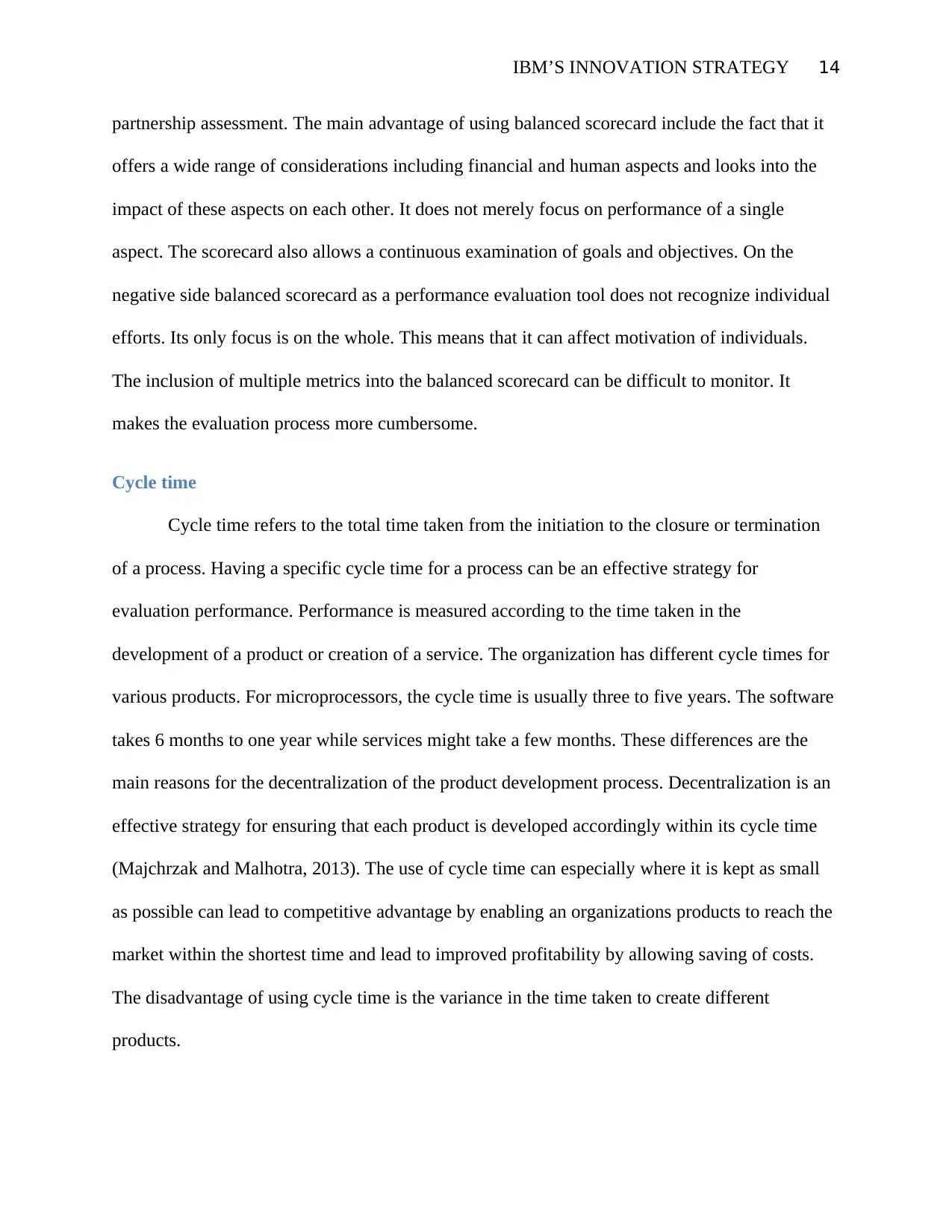
IBM’S INNOVATION STRATEGY 14
partnership assessment. The main advantage of using balanced scorecard include the fact that it
offers a wide range of considerations including financial and human aspects and looks into the
impact of these aspects on each other. It does not merely focus on performance of a single
aspect. The scorecard also allows a continuous examination of goals and objectives. On the
negative side balanced scorecard as a performance evaluation tool does not recognize individual
efforts. Its only focus is on the whole. This means that it can affect motivation of individuals.
The inclusion of multiple metrics into the balanced scorecard can be difficult to monitor. It
makes the evaluation process more cumbersome.
Cycle time
Cycle time refers to the total time taken from the initiation to the closure or termination
of a process. Having a specific cycle time for a process can be an effective strategy for
evaluation performance. Performance is measured according to the time taken in the
development of a product or creation of a service. The organization has different cycle times for
various products. For microprocessors, the cycle time is usually three to five years. The software
takes 6 months to one year while services might take a few months. These differences are the
main reasons for the decentralization of the product development process. Decentralization is an
effective strategy for ensuring that each product is developed accordingly within its cycle time
(Majchrzak and Malhotra, 2013). The use of cycle time can especially where it is kept as small
as possible can lead to competitive advantage by enabling an organizations products to reach the
market within the shortest time and lead to improved profitability by allowing saving of costs.
The disadvantage of using cycle time is the variance in the time taken to create different
products.
partnership assessment. The main advantage of using balanced scorecard include the fact that it
offers a wide range of considerations including financial and human aspects and looks into the
impact of these aspects on each other. It does not merely focus on performance of a single
aspect. The scorecard also allows a continuous examination of goals and objectives. On the
negative side balanced scorecard as a performance evaluation tool does not recognize individual
efforts. Its only focus is on the whole. This means that it can affect motivation of individuals.
The inclusion of multiple metrics into the balanced scorecard can be difficult to monitor. It
makes the evaluation process more cumbersome.
Cycle time
Cycle time refers to the total time taken from the initiation to the closure or termination
of a process. Having a specific cycle time for a process can be an effective strategy for
evaluation performance. Performance is measured according to the time taken in the
development of a product or creation of a service. The organization has different cycle times for
various products. For microprocessors, the cycle time is usually three to five years. The software
takes 6 months to one year while services might take a few months. These differences are the
main reasons for the decentralization of the product development process. Decentralization is an
effective strategy for ensuring that each product is developed accordingly within its cycle time
(Majchrzak and Malhotra, 2013). The use of cycle time can especially where it is kept as small
as possible can lead to competitive advantage by enabling an organizations products to reach the
market within the shortest time and lead to improved profitability by allowing saving of costs.
The disadvantage of using cycle time is the variance in the time taken to create different
products.
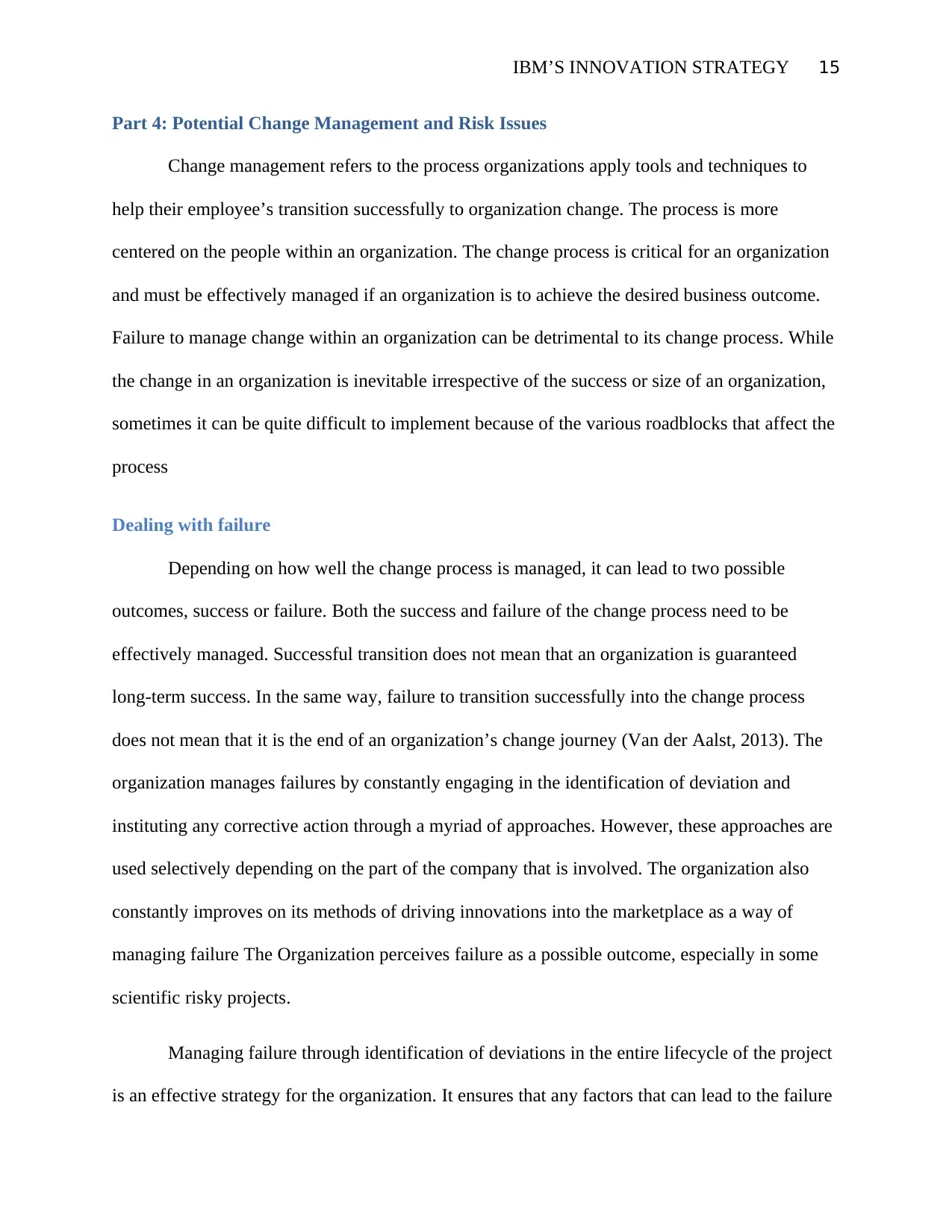
IBM’S INNOVATION STRATEGY 15
Part 4: Potential Change Management and Risk Issues
Change management refers to the process organizations apply tools and techniques to
help their employee’s transition successfully to organization change. The process is more
centered on the people within an organization. The change process is critical for an organization
and must be effectively managed if an organization is to achieve the desired business outcome.
Failure to manage change within an organization can be detrimental to its change process. While
the change in an organization is inevitable irrespective of the success or size of an organization,
sometimes it can be quite difficult to implement because of the various roadblocks that affect the
process
Dealing with failure
Depending on how well the change process is managed, it can lead to two possible
outcomes, success or failure. Both the success and failure of the change process need to be
effectively managed. Successful transition does not mean that an organization is guaranteed
long-term success. In the same way, failure to transition successfully into the change process
does not mean that it is the end of an organization’s change journey (Van der Aalst, 2013). The
organization manages failures by constantly engaging in the identification of deviation and
instituting any corrective action through a myriad of approaches. However, these approaches are
used selectively depending on the part of the company that is involved. The organization also
constantly improves on its methods of driving innovations into the marketplace as a way of
managing failure The Organization perceives failure as a possible outcome, especially in some
scientific risky projects.
Managing failure through identification of deviations in the entire lifecycle of the project
is an effective strategy for the organization. It ensures that any factors that can lead to the failure
Part 4: Potential Change Management and Risk Issues
Change management refers to the process organizations apply tools and techniques to
help their employee’s transition successfully to organization change. The process is more
centered on the people within an organization. The change process is critical for an organization
and must be effectively managed if an organization is to achieve the desired business outcome.
Failure to manage change within an organization can be detrimental to its change process. While
the change in an organization is inevitable irrespective of the success or size of an organization,
sometimes it can be quite difficult to implement because of the various roadblocks that affect the
process
Dealing with failure
Depending on how well the change process is managed, it can lead to two possible
outcomes, success or failure. Both the success and failure of the change process need to be
effectively managed. Successful transition does not mean that an organization is guaranteed
long-term success. In the same way, failure to transition successfully into the change process
does not mean that it is the end of an organization’s change journey (Van der Aalst, 2013). The
organization manages failures by constantly engaging in the identification of deviation and
instituting any corrective action through a myriad of approaches. However, these approaches are
used selectively depending on the part of the company that is involved. The organization also
constantly improves on its methods of driving innovations into the marketplace as a way of
managing failure The Organization perceives failure as a possible outcome, especially in some
scientific risky projects.
Managing failure through identification of deviations in the entire lifecycle of the project
is an effective strategy for the organization. It ensures that any factors that can lead to the failure
You're viewing a preview
Unlock full access by subscribing today!
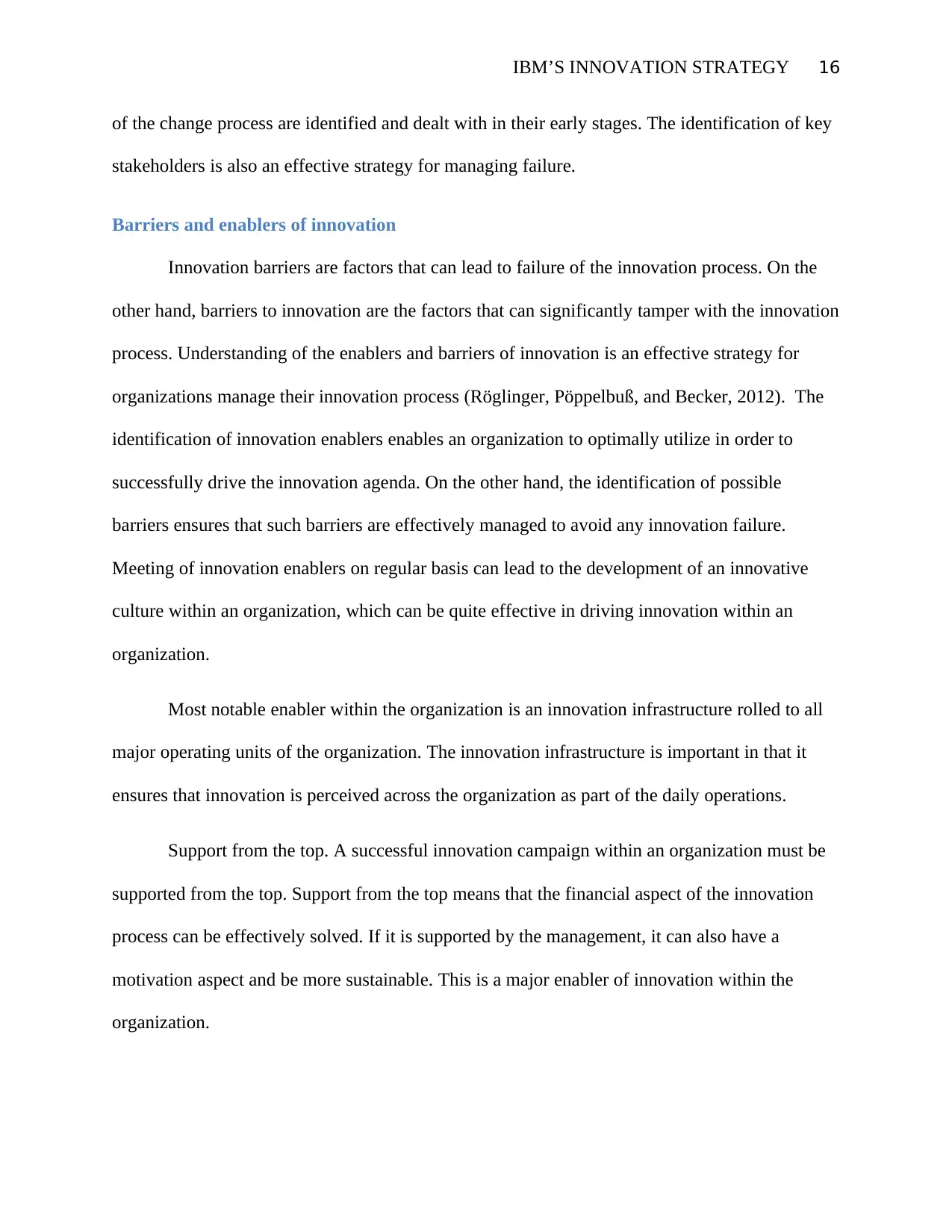
IBM’S INNOVATION STRATEGY 16
of the change process are identified and dealt with in their early stages. The identification of key
stakeholders is also an effective strategy for managing failure.
Barriers and enablers of innovation
Innovation barriers are factors that can lead to failure of the innovation process. On the
other hand, barriers to innovation are the factors that can significantly tamper with the innovation
process. Understanding of the enablers and barriers of innovation is an effective strategy for
organizations manage their innovation process (Röglinger, Pöppelbuß, and Becker, 2012). The
identification of innovation enablers enables an organization to optimally utilize in order to
successfully drive the innovation agenda. On the other hand, the identification of possible
barriers ensures that such barriers are effectively managed to avoid any innovation failure.
Meeting of innovation enablers on regular basis can lead to the development of an innovative
culture within an organization, which can be quite effective in driving innovation within an
organization.
Most notable enabler within the organization is an innovation infrastructure rolled to all
major operating units of the organization. The innovation infrastructure is important in that it
ensures that innovation is perceived across the organization as part of the daily operations.
Support from the top. A successful innovation campaign within an organization must be
supported from the top. Support from the top means that the financial aspect of the innovation
process can be effectively solved. If it is supported by the management, it can also have a
motivation aspect and be more sustainable. This is a major enabler of innovation within the
organization.
of the change process are identified and dealt with in their early stages. The identification of key
stakeholders is also an effective strategy for managing failure.
Barriers and enablers of innovation
Innovation barriers are factors that can lead to failure of the innovation process. On the
other hand, barriers to innovation are the factors that can significantly tamper with the innovation
process. Understanding of the enablers and barriers of innovation is an effective strategy for
organizations manage their innovation process (Röglinger, Pöppelbuß, and Becker, 2012). The
identification of innovation enablers enables an organization to optimally utilize in order to
successfully drive the innovation agenda. On the other hand, the identification of possible
barriers ensures that such barriers are effectively managed to avoid any innovation failure.
Meeting of innovation enablers on regular basis can lead to the development of an innovative
culture within an organization, which can be quite effective in driving innovation within an
organization.
Most notable enabler within the organization is an innovation infrastructure rolled to all
major operating units of the organization. The innovation infrastructure is important in that it
ensures that innovation is perceived across the organization as part of the daily operations.
Support from the top. A successful innovation campaign within an organization must be
supported from the top. Support from the top means that the financial aspect of the innovation
process can be effectively solved. If it is supported by the management, it can also have a
motivation aspect and be more sustainable. This is a major enabler of innovation within the
organization.
Paraphrase This Document
Need a fresh take? Get an instant paraphrase of this document with our AI Paraphraser
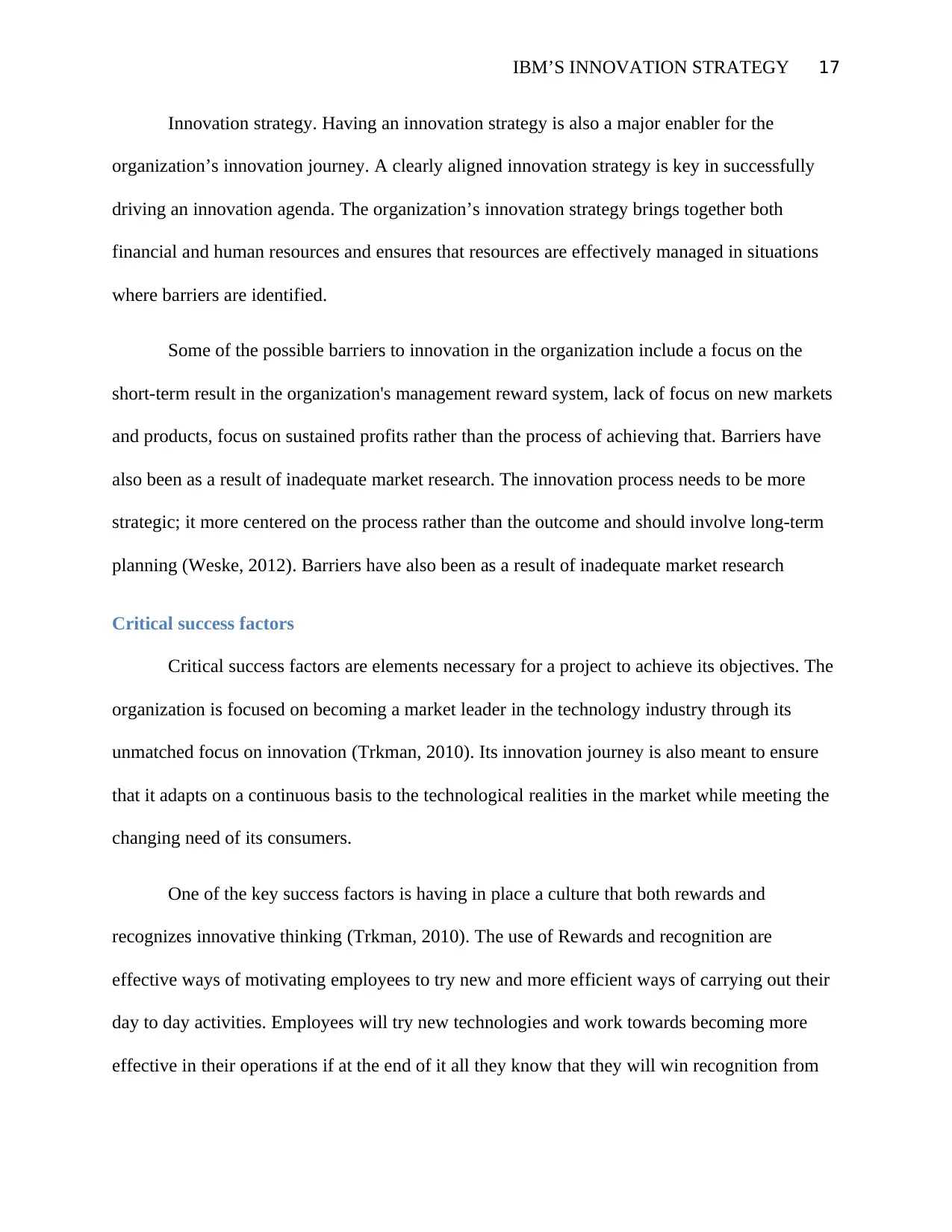
IBM’S INNOVATION STRATEGY 17
Innovation strategy. Having an innovation strategy is also a major enabler for the
organization’s innovation journey. A clearly aligned innovation strategy is key in successfully
driving an innovation agenda. The organization’s innovation strategy brings together both
financial and human resources and ensures that resources are effectively managed in situations
where barriers are identified.
Some of the possible barriers to innovation in the organization include a focus on the
short-term result in the organization's management reward system, lack of focus on new markets
and products, focus on sustained profits rather than the process of achieving that. Barriers have
also been as a result of inadequate market research. The innovation process needs to be more
strategic; it more centered on the process rather than the outcome and should involve long-term
planning (Weske, 2012). Barriers have also been as a result of inadequate market research
Critical success factors
Critical success factors are elements necessary for a project to achieve its objectives. The
organization is focused on becoming a market leader in the technology industry through its
unmatched focus on innovation (Trkman, 2010). Its innovation journey is also meant to ensure
that it adapts on a continuous basis to the technological realities in the market while meeting the
changing need of its consumers.
One of the key success factors is having in place a culture that both rewards and
recognizes innovative thinking (Trkman, 2010). The use of Rewards and recognition are
effective ways of motivating employees to try new and more efficient ways of carrying out their
day to day activities. Employees will try new technologies and work towards becoming more
effective in their operations if at the end of it all they know that they will win recognition from
Innovation strategy. Having an innovation strategy is also a major enabler for the
organization’s innovation journey. A clearly aligned innovation strategy is key in successfully
driving an innovation agenda. The organization’s innovation strategy brings together both
financial and human resources and ensures that resources are effectively managed in situations
where barriers are identified.
Some of the possible barriers to innovation in the organization include a focus on the
short-term result in the organization's management reward system, lack of focus on new markets
and products, focus on sustained profits rather than the process of achieving that. Barriers have
also been as a result of inadequate market research. The innovation process needs to be more
strategic; it more centered on the process rather than the outcome and should involve long-term
planning (Weske, 2012). Barriers have also been as a result of inadequate market research
Critical success factors
Critical success factors are elements necessary for a project to achieve its objectives. The
organization is focused on becoming a market leader in the technology industry through its
unmatched focus on innovation (Trkman, 2010). Its innovation journey is also meant to ensure
that it adapts on a continuous basis to the technological realities in the market while meeting the
changing need of its consumers.
One of the key success factors is having in place a culture that both rewards and
recognizes innovative thinking (Trkman, 2010). The use of Rewards and recognition are
effective ways of motivating employees to try new and more efficient ways of carrying out their
day to day activities. Employees will try new technologies and work towards becoming more
effective in their operations if at the end of it all they know that they will win recognition from

IBM’S INNOVATION STRATEGY 18
the management, monetary or non-monetary rewards. These rewards should, however, be
focused on long-term goals
Collaboration is the other key success factor used by the organization. The organization
recognizes collaboration as an effective way of encouraging and sustaining innovation. Under its
collaborative strategy, the organization is focused on ensuring that its initiatives are implemented
successfully without any hurdles (Dittrich, Duysters and de Man, 2007)Collaboration is
advantageous in that it helps employees solve fundamental challenges encountered in the
innovation process. Besides it also plays a role in ensuring that all employees remain on course
and motivate each other towards achieving sustainable innovation in the organization. A
collaborative approach can also improve the innovative capabilities of an organization and
enable the least innovative employees to catch up with others. However, the collaborative
approach to innovation may not be the most effective for all employees and situations requiring
innovative solutions. For some employees, they are more innovative when working on individual
projects. Collaboration also means that the innovation process is focused on seeking the input of
multiple players which can lead to time wastage especially for challenges requiring timely
innovative solutions.
Lessons learnt and path for future.
From the IBM case study, we can learn a number of lessons. The first innovation is an
important aspect of the growth of an organization (Gehani, 2013). Through innovation;
technology organizations like IBM are able to come up groundbreaking inventions which not
only give them a competitive edge but also improve their ability to satisfy changing customer
needs. We can also learn the importance of investing in research and development as a way of
enhancing the innovativeness of an organization. Thirdly, the role of management in driving
the management, monetary or non-monetary rewards. These rewards should, however, be
focused on long-term goals
Collaboration is the other key success factor used by the organization. The organization
recognizes collaboration as an effective way of encouraging and sustaining innovation. Under its
collaborative strategy, the organization is focused on ensuring that its initiatives are implemented
successfully without any hurdles (Dittrich, Duysters and de Man, 2007)Collaboration is
advantageous in that it helps employees solve fundamental challenges encountered in the
innovation process. Besides it also plays a role in ensuring that all employees remain on course
and motivate each other towards achieving sustainable innovation in the organization. A
collaborative approach can also improve the innovative capabilities of an organization and
enable the least innovative employees to catch up with others. However, the collaborative
approach to innovation may not be the most effective for all employees and situations requiring
innovative solutions. For some employees, they are more innovative when working on individual
projects. Collaboration also means that the innovation process is focused on seeking the input of
multiple players which can lead to time wastage especially for challenges requiring timely
innovative solutions.
Lessons learnt and path for future.
From the IBM case study, we can learn a number of lessons. The first innovation is an
important aspect of the growth of an organization (Gehani, 2013). Through innovation;
technology organizations like IBM are able to come up groundbreaking inventions which not
only give them a competitive edge but also improve their ability to satisfy changing customer
needs. We can also learn the importance of investing in research and development as a way of
enhancing the innovativeness of an organization. Thirdly, the role of management in driving
You're viewing a preview
Unlock full access by subscribing today!

IBM’S INNOVATION STRATEGY 19
organization innovation is also explicitly brought out in the case study, the chances of success for
a management driven innovation are high as compared to employee-driven innovation
(Rosemann and vom Brocke,2015). In addition, external relationships are an important part of
the organizational transformation. In the course of bringing about substantial changes in an
organization, challenges are inevitable. It is therefore important that change management
processes are established to effectively drive the change process.
One of the major focuses of the organization is minimizing cost in its operations. While
the company is viewed as one of the most innovative in the world, its innovation is not centered
on product differentiation. This fact, therefore, means that its competitors can easily imitate its
technological products. One of its focuses in future should, therefore, be using its innovative
capability to create more unique products, unlikely to be copied by its competitors. The company
should also focus more on diversifying its products. Diversification will enable it to enter more
markets and act as a buffer to the risks associated with.
Conclusion
In conclusion, IBM is one of the most innovative organizations in the world; the
organization which is majorly involved in technological inventions has had an impressive
innovation journey dating from over 90 years ago. Its focus on being a market technological
innovation leader has seen the organization has seen the organization invest a significant amount
of resources in its research and development endeavors. To strengthen its innovative journey, the
organization has over 3000 engineers and scientists and 24 development laboratories distributed
across the world. The organization has incorporated innovation as part of its business model and
views it as an integral organizing principle. It also relies on technology as a way of reinventing
organization innovation is also explicitly brought out in the case study, the chances of success for
a management driven innovation are high as compared to employee-driven innovation
(Rosemann and vom Brocke,2015). In addition, external relationships are an important part of
the organizational transformation. In the course of bringing about substantial changes in an
organization, challenges are inevitable. It is therefore important that change management
processes are established to effectively drive the change process.
One of the major focuses of the organization is minimizing cost in its operations. While
the company is viewed as one of the most innovative in the world, its innovation is not centered
on product differentiation. This fact, therefore, means that its competitors can easily imitate its
technological products. One of its focuses in future should, therefore, be using its innovative
capability to create more unique products, unlikely to be copied by its competitors. The company
should also focus more on diversifying its products. Diversification will enable it to enter more
markets and act as a buffer to the risks associated with.
Conclusion
In conclusion, IBM is one of the most innovative organizations in the world; the
organization which is majorly involved in technological inventions has had an impressive
innovation journey dating from over 90 years ago. Its focus on being a market technological
innovation leader has seen the organization has seen the organization invest a significant amount
of resources in its research and development endeavors. To strengthen its innovative journey, the
organization has over 3000 engineers and scientists and 24 development laboratories distributed
across the world. The organization has incorporated innovation as part of its business model and
views it as an integral organizing principle. It also relies on technology as a way of reinventing
Paraphrase This Document
Need a fresh take? Get an instant paraphrase of this document with our AI Paraphraser
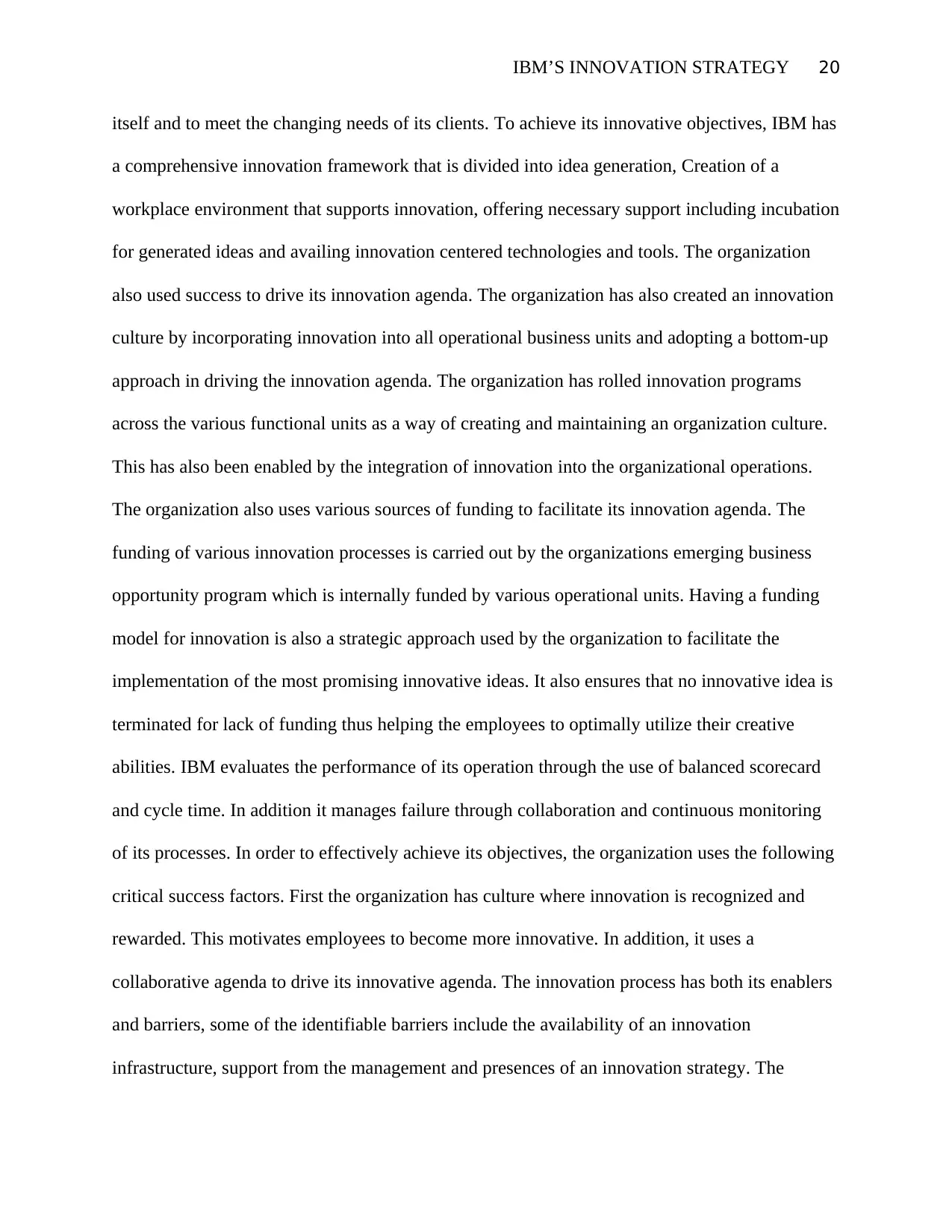
IBM’S INNOVATION STRATEGY 20
itself and to meet the changing needs of its clients. To achieve its innovative objectives, IBM has
a comprehensive innovation framework that is divided into idea generation, Creation of a
workplace environment that supports innovation, offering necessary support including incubation
for generated ideas and availing innovation centered technologies and tools. The organization
also used success to drive its innovation agenda. The organization has also created an innovation
culture by incorporating innovation into all operational business units and adopting a bottom-up
approach in driving the innovation agenda. The organization has rolled innovation programs
across the various functional units as a way of creating and maintaining an organization culture.
This has also been enabled by the integration of innovation into the organizational operations.
The organization also uses various sources of funding to facilitate its innovation agenda. The
funding of various innovation processes is carried out by the organizations emerging business
opportunity program which is internally funded by various operational units. Having a funding
model for innovation is also a strategic approach used by the organization to facilitate the
implementation of the most promising innovative ideas. It also ensures that no innovative idea is
terminated for lack of funding thus helping the employees to optimally utilize their creative
abilities. IBM evaluates the performance of its operation through the use of balanced scorecard
and cycle time. In addition it manages failure through collaboration and continuous monitoring
of its processes. In order to effectively achieve its objectives, the organization uses the following
critical success factors. First the organization has culture where innovation is recognized and
rewarded. This motivates employees to become more innovative. In addition, it uses a
collaborative agenda to drive its innovative agenda. The innovation process has both its enablers
and barriers, some of the identifiable barriers include the availability of an innovation
infrastructure, support from the management and presences of an innovation strategy. The
itself and to meet the changing needs of its clients. To achieve its innovative objectives, IBM has
a comprehensive innovation framework that is divided into idea generation, Creation of a
workplace environment that supports innovation, offering necessary support including incubation
for generated ideas and availing innovation centered technologies and tools. The organization
also used success to drive its innovation agenda. The organization has also created an innovation
culture by incorporating innovation into all operational business units and adopting a bottom-up
approach in driving the innovation agenda. The organization has rolled innovation programs
across the various functional units as a way of creating and maintaining an organization culture.
This has also been enabled by the integration of innovation into the organizational operations.
The organization also uses various sources of funding to facilitate its innovation agenda. The
funding of various innovation processes is carried out by the organizations emerging business
opportunity program which is internally funded by various operational units. Having a funding
model for innovation is also a strategic approach used by the organization to facilitate the
implementation of the most promising innovative ideas. It also ensures that no innovative idea is
terminated for lack of funding thus helping the employees to optimally utilize their creative
abilities. IBM evaluates the performance of its operation through the use of balanced scorecard
and cycle time. In addition it manages failure through collaboration and continuous monitoring
of its processes. In order to effectively achieve its objectives, the organization uses the following
critical success factors. First the organization has culture where innovation is recognized and
rewarded. This motivates employees to become more innovative. In addition, it uses a
collaborative agenda to drive its innovative agenda. The innovation process has both its enablers
and barriers, some of the identifiable barriers include the availability of an innovation
infrastructure, support from the management and presences of an innovation strategy. The

IBM’S INNOVATION STRATEGY 21
possible barriers include lack of sufficient market research, lack of focus on product
diversification and differentiation and focus on profits instead of the process of achieving those
profits
References
Bjelland, O.M., and Wood, R.C., 2008. An inside view of IBM's' Innovation Jam'. MIT Sloan
management review, 50(1), p.32.
Chesbrough, H., 2007. Business model innovation: it's not just about technology anymore.
Strategy & leadership, 35(6), pp.12-17.
Dittrich, K., Duysters, G. and de Man, A.P., 2007. Strategic repositioning by means of alliance
networks: The case of IBM. Research Policy, 36(10), pp.1496-1511.
Hammer, M., 2015. What is business process management?. In Handbook on Business Process
Management 1 (pp. 3-16). Springer, Berlin, Heidelberg.
possible barriers include lack of sufficient market research, lack of focus on product
diversification and differentiation and focus on profits instead of the process of achieving those
profits
References
Bjelland, O.M., and Wood, R.C., 2008. An inside view of IBM's' Innovation Jam'. MIT Sloan
management review, 50(1), p.32.
Chesbrough, H., 2007. Business model innovation: it's not just about technology anymore.
Strategy & leadership, 35(6), pp.12-17.
Dittrich, K., Duysters, G. and de Man, A.P., 2007. Strategic repositioning by means of alliance
networks: The case of IBM. Research Policy, 36(10), pp.1496-1511.
Hammer, M., 2015. What is business process management?. In Handbook on Business Process
Management 1 (pp. 3-16). Springer, Berlin, Heidelberg.
You're viewing a preview
Unlock full access by subscribing today!
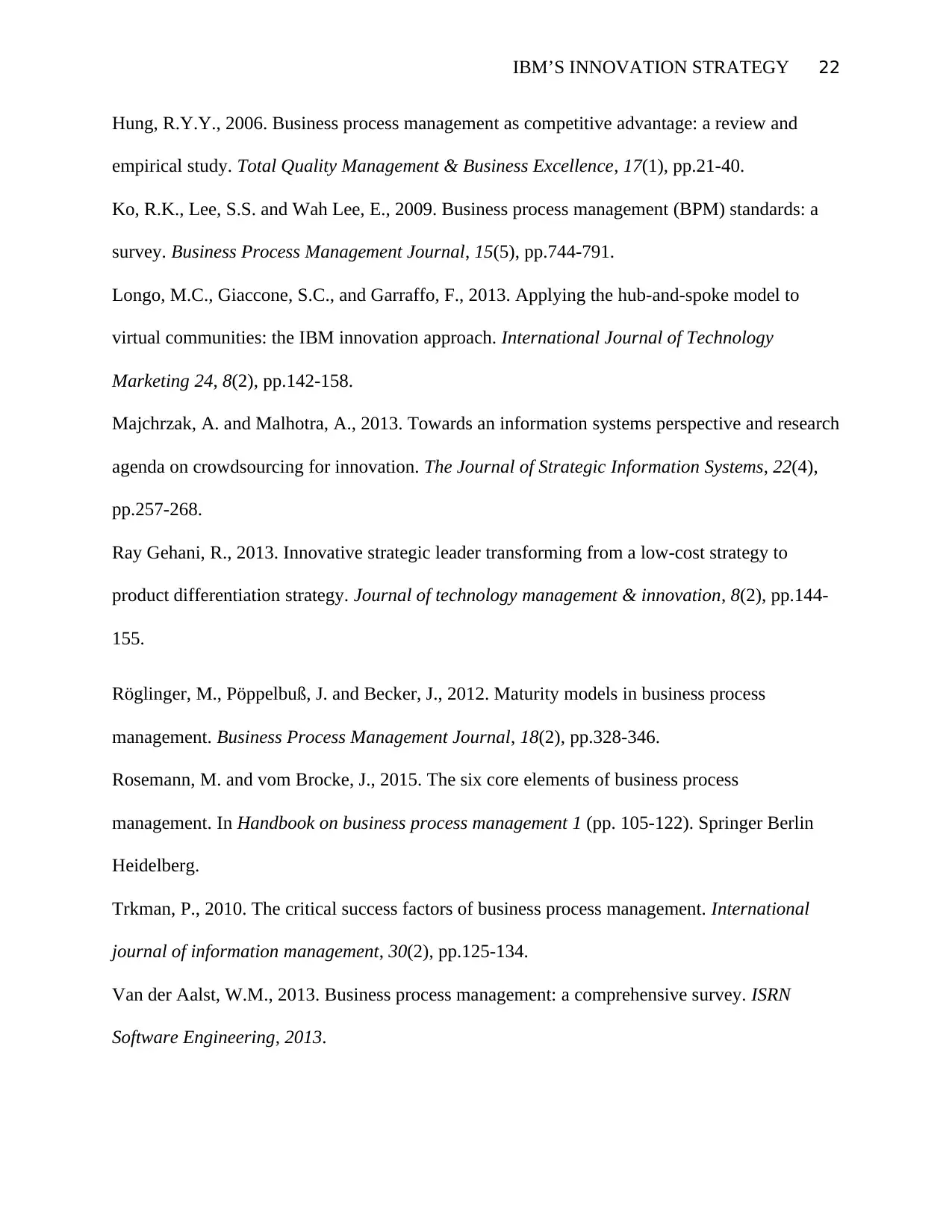
IBM’S INNOVATION STRATEGY 22
Hung, R.Y.Y., 2006. Business process management as competitive advantage: a review and
empirical study. Total Quality Management & Business Excellence, 17(1), pp.21-40.
Ko, R.K., Lee, S.S. and Wah Lee, E., 2009. Business process management (BPM) standards: a
survey. Business Process Management Journal, 15(5), pp.744-791.
Longo, M.C., Giaccone, S.C., and Garraffo, F., 2013. Applying the hub-and-spoke model to
virtual communities: the IBM innovation approach. International Journal of Technology
Marketing 24, 8(2), pp.142-158.
Majchrzak, A. and Malhotra, A., 2013. Towards an information systems perspective and research
agenda on crowdsourcing for innovation. The Journal of Strategic Information Systems, 22(4),
pp.257-268.
Ray Gehani, R., 2013. Innovative strategic leader transforming from a low-cost strategy to
product differentiation strategy. Journal of technology management & innovation, 8(2), pp.144-
155.
Röglinger, M., Pöppelbuß, J. and Becker, J., 2012. Maturity models in business process
management. Business Process Management Journal, 18(2), pp.328-346.
Rosemann, M. and vom Brocke, J., 2015. The six core elements of business process
management. In Handbook on business process management 1 (pp. 105-122). Springer Berlin
Heidelberg.
Trkman, P., 2010. The critical success factors of business process management. International
journal of information management, 30(2), pp.125-134.
Van der Aalst, W.M., 2013. Business process management: a comprehensive survey. ISRN
Software Engineering, 2013.
Hung, R.Y.Y., 2006. Business process management as competitive advantage: a review and
empirical study. Total Quality Management & Business Excellence, 17(1), pp.21-40.
Ko, R.K., Lee, S.S. and Wah Lee, E., 2009. Business process management (BPM) standards: a
survey. Business Process Management Journal, 15(5), pp.744-791.
Longo, M.C., Giaccone, S.C., and Garraffo, F., 2013. Applying the hub-and-spoke model to
virtual communities: the IBM innovation approach. International Journal of Technology
Marketing 24, 8(2), pp.142-158.
Majchrzak, A. and Malhotra, A., 2013. Towards an information systems perspective and research
agenda on crowdsourcing for innovation. The Journal of Strategic Information Systems, 22(4),
pp.257-268.
Ray Gehani, R., 2013. Innovative strategic leader transforming from a low-cost strategy to
product differentiation strategy. Journal of technology management & innovation, 8(2), pp.144-
155.
Röglinger, M., Pöppelbuß, J. and Becker, J., 2012. Maturity models in business process
management. Business Process Management Journal, 18(2), pp.328-346.
Rosemann, M. and vom Brocke, J., 2015. The six core elements of business process
management. In Handbook on business process management 1 (pp. 105-122). Springer Berlin
Heidelberg.
Trkman, P., 2010. The critical success factors of business process management. International
journal of information management, 30(2), pp.125-134.
Van der Aalst, W.M., 2013. Business process management: a comprehensive survey. ISRN
Software Engineering, 2013.
Paraphrase This Document
Need a fresh take? Get an instant paraphrase of this document with our AI Paraphraser

IBM’S INNOVATION STRATEGY 23
Vom Brocke, J., Petry, M., and Gonser, T., 2016. Business process management. In A Handbook
of Business Transformation Management Methodology (pp. 137-172). Routledge.
Weske, M., 2012. Business process management architectures. In Business Process Management
(pp. 333-371). Springer, Berlin, Heidelberg.
Vom Brocke, J., Petry, M., and Gonser, T., 2016. Business process management. In A Handbook
of Business Transformation Management Methodology (pp. 137-172). Routledge.
Weske, M., 2012. Business process management architectures. In Business Process Management
(pp. 333-371). Springer, Berlin, Heidelberg.
1 out of 23
Related Documents
Your All-in-One AI-Powered Toolkit for Academic Success.
+13062052269
info@desklib.com
Available 24*7 on WhatsApp / Email
![[object Object]](/_next/static/media/star-bottom.7253800d.svg)
Unlock your academic potential
© 2024 | Zucol Services PVT LTD | All rights reserved.





